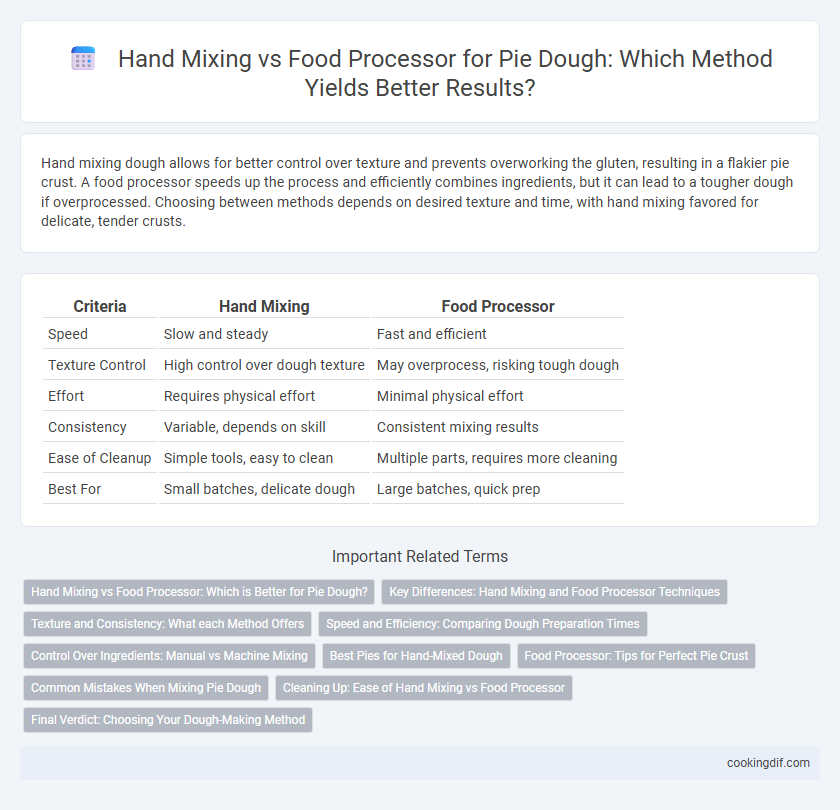Hand mixing dough allows for better control over texture and prevents overworking the gluten, resulting in a flakier pie crust. A food processor speeds up the process and efficiently combines ingredients, but it can lead to a tougher dough if overprocessed. Choosing between methods depends on desired texture and time, with hand mixing favored for delicate, tender crusts.
Table of Comparison
| Criteria | Hand Mixing | Food Processor |
|---|---|---|
| Speed | Slow and steady | Fast and efficient |
| Texture Control | High control over dough texture | May overprocess, risking tough dough |
| Effort | Requires physical effort | Minimal physical effort |
| Consistency | Variable, depends on skill | Consistent mixing results |
| Ease of Cleanup | Simple tools, easy to clean | Multiple parts, requires more cleaning |
| Best For | Small batches, delicate dough | Large batches, quick prep |
Hand Mixing vs Food Processor: Which is Better for Pie Dough?
Hand mixing pie dough offers greater control over texture, allowing precise incorporation of ingredients and preventing overworking the gluten, which results in a tender, flaky crust. Food processors provide speed and efficiency, quickly combining butter and flour while chilling the dough to maintain flakiness, but risk overheating and overmixing if not carefully monitored. Choosing between hand mixing and a food processor depends on balancing texture control with convenience for optimal pie dough results.
Key Differences: Hand Mixing and Food Processor Techniques
Hand mixing pie dough allows for greater control over texture by gently combining ingredients to prevent overworking gluten, resulting in a flakier crust. Food processors rapidly incorporate fat into flour, creating a more uniform mixture but risk overheating the dough, which can affect flakiness. While hand mixing is time-intensive and tactile, food processors offer speed and consistency, making each technique suitable for different baking preferences and outcomes.
Texture and Consistency: What each Method Offers
Hand mixing pie dough allows greater control over texture, producing a flakier and more tender crust by gently combining ingredients without overworking the dough. Food processors expedite the process, delivering consistent dough with uniform crumb size, ideal for a quicker, sturdier crust. Choosing between methods depends on the desired balance between delicate texture and processing speed for pie crust perfection.
Speed and Efficiency: Comparing Dough Preparation Times
Hand mixing dough typically takes 10 to 15 minutes, allowing better control over texture but requiring more physical effort. Food processors can prepare dough in under 5 minutes, significantly increasing speed and efficiency while producing consistent results. For quick pie preparations, a food processor offers a time-saving advantage, especially when making multiple batches.
Control Over Ingredients: Manual vs Machine Mixing
Hand mixing dough offers greater control over ingredient incorporation, allowing for precise adjustments in texture and consistency based on tactile feedback. In contrast, a food processor rapidly combines ingredients but may overwork the dough, risking a tougher crust due to less control over mixing duration. Choosing manual mixing enhances the ability to monitor gluten development and achieve a delicate, flaky pie crust.
Best Pies for Hand-Mixed Dough
Hand-mixed dough creates a tender, flaky texture ideal for delicate pies such as apple, cherry, and blueberry, where controlling gluten development is crucial. The gentle mixing preserves small butter pieces that melt during baking, yielding a superior crust compared to the uniform consistency from a food processor. Classic fruit pies and savory pot pies benefit most from hand-mixed dough, ensuring a flaky, tender crust that enhances overall flavor and texture.
Food Processor: Tips for Perfect Pie Crust
Using a food processor for pie crust helps achieve a perfectly flaky texture by quickly combining cold butter and flour without overworking the dough. Pulse the ingredients just until they resemble coarse crumbs, then add ice-cold water gradually to avoid a soggy crust. Chilling the dough after mixing ensures easier rolling and prevents shrinking during baking, resulting in a tender, evenly baked pie crust.
Common Mistakes When Mixing Pie Dough
Overmixing pie dough by hand or in a food processor causes gluten development, resulting in tough crusts rather than flaky textures. Using a food processor can lead to uneven mixing or overheating the butter, while hand mixing risks inconsistent incorporation of ingredients. Avoid pressing or kneading the dough excessively to prevent loss of the desired crumbly structure essential for perfect pie crusts.
Cleaning Up: Ease of Hand Mixing vs Food Processor
Hand mixing dough offers a straightforward clean-up process, requiring only basic utensils like a bowl and spoon, which can be quickly washed by hand. Food processors, on the other hand, involve multiple parts such as the bowl, blade, and lid, all of which must be thoroughly cleaned to prevent dough residue buildup. While food processors save time during dough preparation, hand mixing ultimately reduces post-baking clean-up effort.
Final Verdict: Choosing Your Dough-Making Method
Hand mixing dough allows greater control over texture and prevents overworking gluten, which is ideal for tender pie crusts. Food processors provide speed and consistency, efficiently combining ingredients but risk heat generation that can toughen dough. Selecting the best method depends on desired crust tenderness, time constraints, and personal comfort with the tools.
Hand mixing vs food processor for dough Infographic

 cookingdif.com
cookingdif.com